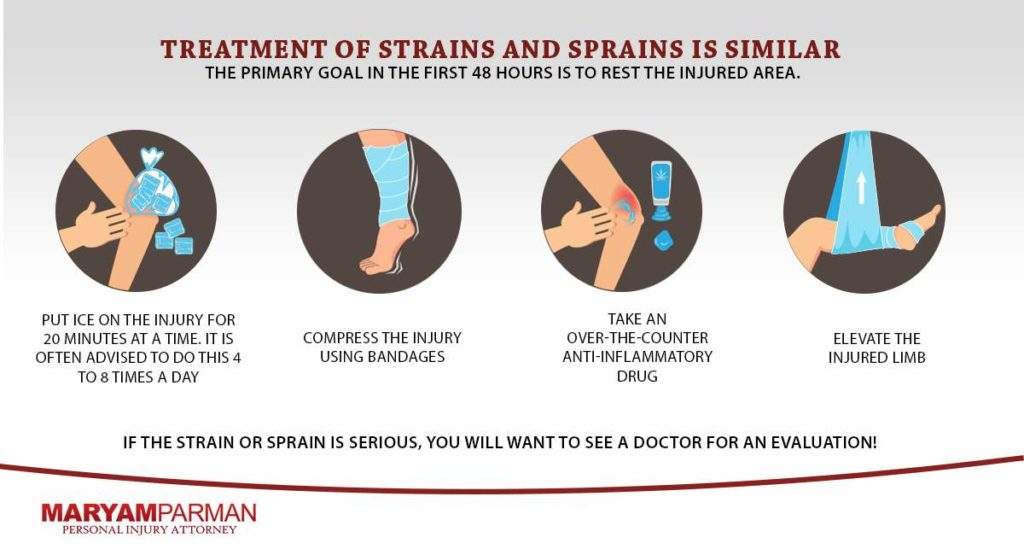How many times have you limped home after a sporting activity only to be slowed by the pain and swelling? Do you know whether you have a sprain or strain?
Strains and sprains are typical problems in busy folks, and typically they will not be serious. No matter the seriousness of the problem, though, it is always smart to have an injury diagnosed by a doctor.
Is There a Difference Between Sprains and Strains?
There are many similarities between these two types of injuries. Both have varying degrees of severity ranging from 1st to 3rd degree. And both are used to describe a stretching or tearing injury to the body.
Just What Is a Strain?
A muscle strain is tearing or hyperextending of a muscle or a tendon. A tendon is a fibrous connective tissue that attaches muscles to bones. A muscle strain takes place when a person lifts heavy objects or hyperextend a muscle. Muscle strains are also called pulled muscles.
Types of muscle strains could be back strain and tendonitis. You can get three distinct strain grades: Grade 1 is a mild injury to the muscle fiber. In a grade 2 muscle strain, more muscle or tendon is hurt, but the muscle tissue just isn’t entirely torn. Grade 3 is a total tear of a muscle tissue and quite often must have surgical repair.
What Exactly Is Sprain?
A sprain is stressing or rupture of your ligaments. A ligament is an elastic fibrous tissue that joins one bone to another bone, and most can be found in the joints such as the elbows, wrists, ankles, and fingers.
Sprains often happen whenever people fall on an outstretched limb, or should they unintentionally twist a joint. This leads to tearing and also stretching of your ligaments. The consequence could be some bruising, discomfort and lack of movement. Different types of sprains could be ankle and finger sprains. The seriousness of sprains is also grouped into degrees of sprains, comparable to strains.
Grades of Sprains
Grade 1 Sprain
These injuries are a minor overstretching or slight tearing of a ligament without having joint lack of stability. People who have grade 1 sprains go through slight pain and minimal inflammation, without having discoloration or functional disability.
Grade 2 Sprain
This joint sprain is generally moderate damage to the soft tissue of the joint. It will have definite discomfort, bruising (Little blood vessels are damaged) And puffiness (The blood belonging to the injured blood vessels fill the adjacent tissue). Anyone with a second-grade sprain will be unable to set weight on the afflicted joint and there will be minimal functional disability.
Grade 3 Sprain
It’s a total tearing of the connective tissues of the joint, resulting in serious pain, swelling and discoloration. There will be a complete chronic problem and of course, the patient will not be able to apply pressure on that damaged joint. A health care provider might confuse it with a bone fracture, so an x-ray is usually needed.
Therapy of Sprains
Therapy for joint sprains depends on the severity. Typically, they ought to be treated with the RICE method. The first letter stands for rest. Through much less exercise, the blood is not going to keep going to the neighboring tissue, which often cuts down on inflammation and soreness. The applying ice on the area affected is very helpful. Place ice inside a bag or towel and apply the ice to the damage to lower the inflammation and the pain.
Next, compression by using a brace or wrap to hold still the injured area and provide the injury some time to rest and heal, however it should never too restrictive or it will cut off the circulation of blood. Lastly, elevate the hurt arm or leg; lifting the arm or leg could decrease the inflammation.
After the sprained or strained ligament, muscle or tendon heals, it will be very tight from the immobilization, so you will have to begin a gentle stretching and rehabilitation routine to for stretching purposes. You can find medications to decrease any pain, so the affected person could move and carry out the exercise to regain normal range of motion. These drugs include non-steroidal pain relievers such as acetaminophen, ibuprofen, and aspirin, but that’s the subject of a different document.
You may want to see a physical therapist to learn stretches and exercises that will strengthen the muscles surrounding the injured body part to protect against future injury.
If you happen to have a bad sprain at job and you believe the cause is due to the job itself, give us a call!

